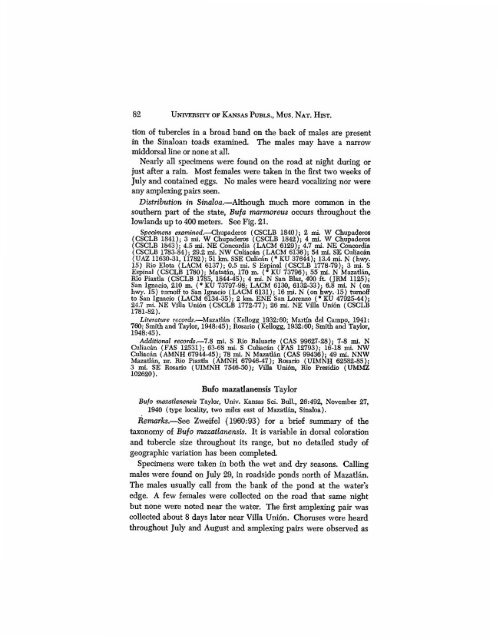The Amphibians and Reptiles of Sinaloa, Mexico - Smithsonian ...
The Amphibians and Reptiles of Sinaloa, Mexico - Smithsonian ...
The Amphibians and Reptiles of Sinaloa, Mexico - Smithsonian ...
You also want an ePaper? Increase the reach of your titles
YUMPU automatically turns print PDFs into web optimized ePapers that Google loves.
82 UNIVERSITY OF KANSAS PUBLS., MUS, NAT. HIST.<br />
tion <strong>of</strong> tubercles in a broad b<strong>and</strong> on the back <strong>of</strong> males are present<br />
in the <strong>Sinaloa</strong>n toads examined. <strong>The</strong> males may have a narrow<br />
middorsal line or none at all.<br />
Nearly all specimens were found on the road at night during or<br />
just after a rain. Most females were taken in the first two weeks <strong>of</strong><br />
July <strong>and</strong> contained eggs. No males were heard vocalizing nor were<br />
any amplexing pairs seen.<br />
Distribution in <strong>Sinaloa</strong>.—Although much more common in the<br />
southern part <strong>of</strong> the state, Bufa marrnoTeus occurs throughout the<br />
lowl<strong>and</strong>s up to 400 meters. See Fig. 21.<br />
Specimens examined.—Chupaderos (CSCLB 1840); 2 mi. W Chupaderos<br />
(CSCLB 1841); 3 mi. W Chupaderos (CSCLB 1842); 4 mi. W Chupaderos<br />
(CSCLB 1843); 4.5 mi. NE Concordia (LACM 6129); 4.7 mi. NE Concordia<br />
(CSCLB 1783-84); 29.2 mi. NW Culiacan {LACM 6136); 54 mi. SE Culiacan<br />
(UAZ 11630-31, 11782); 51 km. SSE Culican ("KU 37644); 13.4 mi. N (hwy.<br />
15) Bio Elota (LACM 6137); 0.5 mi. S Espinal (CSCLB 1778-79); 3 mi. S<br />
Espinal (CSCLB 1780); Matatan, 170 m. ("KU 73796); 55 mi. N Mazatlan,<br />
Rio Piaxtla (CSCLB 1785, 1844-15); 4 mi. N San Bias, 400 ft (JRM 1125);<br />
San Ignacio, 210 m. ('KU 73797-98; LACM 6130, 6132-33); 6.8 mi. N (on<br />
hwy. 15) turn<strong>of</strong>f to San Ignacio (LACM 6131); 16 mi. N (on hwy.-15) tum<strong>of</strong>f<br />
to San Ignacio (LACM 6134-35); 2 km. ENE San Lorenzo ( e KU 47925-44);<br />
24.7 mi. NE Villa Union (CSCLB 1772-77); 26 mi. NE Villa Union (CSCLB<br />
1781-82).<br />
Literature records.—Mazatlan (Kellogg 1932:60; Martin del Campo, 1941:<br />
760; Smith <strong>and</strong> Taylor, 1948:45); Rosario (Kellogg, 1932:60; Smith <strong>and</strong> Taylor,<br />
1948:45).<br />
Additional records.—7.8 mi. S Rio Baluarte (CAS 99627-28); 7-8 mi. N<br />
Culiacan (FAS 12531); 63-68 mi. S Culiacan (FAS 12793); 16-18 mi. NW<br />
Culiacan (AMNH 67944-15); 78 mi. N Mazatlan (CAS 99436); 49 mi. NNW<br />
Mazatlan, nr. Rio Piaztla (AMNH 67946-47); Rosario (UIMNH 62582-85);<br />
3 mi. SE Rosario (UIMNH 7546-50); Villa Union, Rio Presidio (UMMZ<br />
102620).<br />
Bufo maz all anens is Taylor<br />
Bufo mazathnensis Taylor, Univ. Kansas Sci. Bull., 26:492, November 27,<br />
1940 (type locality, two miles east <strong>of</strong> Mazatl&n, <strong>Sinaloa</strong>).<br />
Remarks.—See Zweifel (1960:93) for a brief summary <strong>of</strong> the<br />
taxonomy <strong>of</strong> Bufo mazatlanensis. It is variable in dorsal coloration<br />
<strong>and</strong> tubercle size throughout its range, but no detailed study <strong>of</strong><br />
geographic variation has been completed.<br />
Specimens were taken in both the wet <strong>and</strong> dry seasons. Calling<br />
males were found on July 29, in roadside ponds north <strong>of</strong> Mazatlan.<br />
<strong>The</strong> males usually call from the bank <strong>of</strong> the pond at the waters<br />
edge. A few females were collected on the road that same night<br />
but none were noted near the water. <strong>The</strong> first amplexing pair was<br />
collected about 8 days later near Villa Union. Choruses were heard<br />
throughout July <strong>and</strong> August <strong>and</strong> amplexing pairs were observed as
















